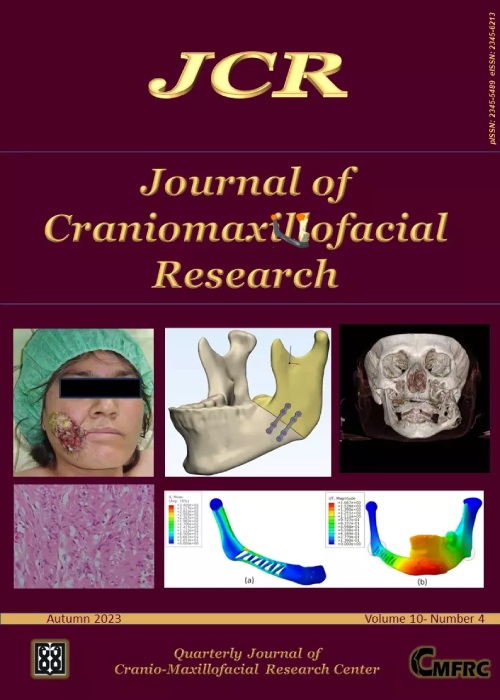فهرست مطالب
Journal of Craniomaxillofacial Research
Volume:6 Issue: 3, Summer 2019
- تاریخ انتشار: 1398/11/19
- تعداد عناوین: 6
-
-
Pages 88-106Introduction
Pain control in patients undergoing orthodontic treatment is one of the major challenges of such treatments. The use of new technologies such as Laser offers promising results in this field. The goal of this study is to survey the works on effect of low-power laser on pain relief during orthodontic treatments.
Materials and MethodsThe key terms including “orthodontics, reduction, pain, low level, power, laser and laser therapy” alone as well as combinations. Those key terms were used to search the databases including “Google Scholar, Science Direct, and PubMed”. The review of collected sources was done which led to selection of 557 papers. The validation was done through CONSORT guidelines.
ResultsAfter review of selected papers, 34 studies including 32 human studies and 2 animal studies were selected.
ConclusionThe positive findings of reviewed studies on use of laser therapy suggest that low power laser could be effective on pain relief. Conducting further studies on this subject will be beneficial.
Keywords: Orthodontics, Pain, Review, Low-power, Laser -
Pages 107-112Introduction
The purpose of this study was to determine the effect of low-level laser therapy on orthodontic pain after the first canine retraction force.
Materials and MethodsThis single-blind split-mouth placebo-controlled randomized clinical trial was performed in 30 orthodontic patients requiring bilateral canine retraction in Shahed University. Once canine retraction was initiated, a single dose of diode laser radiation (660nm, 80MW, and 3.8 J/cm2 density, diameter of the optical fiber tip: 0/45cm2) was administered to a randomly selected maxillary or mandibular quarter for 30s. The other quarter served as the placebo side and was treated using the same device without turning on the laser. On the first, second, fourth, and seventh days, the patients rated the pain they experienced on each side at home by using visual analog scale-based questionnaires. Changes in pain were analyzed using non-parametric analysiswith SPSS software.
ResultsIn patients who experienced pain, a significant pain reduction was notedon the first and fourth days after low-level laser therapy on the experimental side compared to that on the placebo side (P<0.05).
ConclusionA single dose of diodelaser therapy (660nm) can be an efficient modality to reduce the orthodontic pain associated with canine retraction.
Keywords: Canine retraction, Diode laser, Laser irradiation, Low-level laser therapy (LLLT), Orthodontic pain, Visual analog scale (VAS) -
Pages 113-121
In this paper, a full mandibular CT-scan in a specific patient is used to model BSSO surgery. The purpose is to compare the three most common fixation methods which are used in BSSO surgery by finite element method. Three different fixations are studied in order to obtain the minimum displacement of the lower jaw and optimum stress and strain on the specified fixation. The methods are two parallel plates with four screws, the operation of triangular screw configuration and one plate with four screws. The plates and the screw are modeled precisely by point clouds of Synthes Brand’s plate and screw. The mechanical properties of the full mandibular and, to obtain a practical model after the surgery, the mean jaw forces are extracted from literatures. It is resulted that the minimum displacement and stresses on the mandible and fixation tools happened in the Triangular screw configuration model and the two other methods have higher stress and lower displacement. Therefore, the mandibular in triangular method, experiences little deformation and the screws toler-ates lower stress and strain which is better than the other two methods.
Keywords: Finite element analysis, FEA, Sagittal split ramus osteotomy, Parallel plates, Triangularscrew -
Pages 122-128Purpose
One of the required information in rehabilitating the occlusal plane in dentistry is the radius of Monson’s sphere, which like other anatomical indices varies in different races. The purpose of this study was to determine the radius of the Monson’s sphere in a group of Iranian.
Materials and Methods45 Iranian subjects (19 males & 26 females) aged from 18 to 25 were selected for this study. The x,y,z coordinates of cusp tips of all mandibular teeth except for the third molars obtained with a 3-dimensional digitizer, were used to derive a spherical model of the occlusal surfaces’ curvature. From the best interpolating sphere, the radii of the Monson’s sphere was computed.
ResultsAlthough all of the computed variables were greater in men, the occlusal curvature of mandibular arch was not influenced by gender. The mean radius of the Monson’s sphere was 111.5mm (121mm in men and 104mm in women which was closer to the classic value of 4 inch, confirming Monson’s observations).
ConclusionThe average radius of the Monson’s sphere in this study was greater than the classic 4 inch value proposed by Monson and this result may suggest racial differences in the normal dental arch form that is important in occlusal rehabilitation. Although more researches are necessary in future to improve treatment results.
Keywords: Occlusal plane, Monson’s sphere, Curve of spee, Curve of wilson, 3-dimensional digitizer, Iranian adults -
Pages 129-131
Today bilateral sagittal split osteotomy technique is one of the main surgical methods used in mandibular deformities surgical correction. Since, the osteotomy design has an important role in decreasing BSSO complications, we developed a technique which restrict the osteotomy points to posterior medial ramus cut and anterior vertical cut in widely used hunsuck modification for decreasing the complications.
Keywords: Sagittal split ramus osteotomy, Orthognathic surgery, Skeletal deformity -
Pages 132-137
Carcinoma as a primary tumor within the jaw is a rare phenomenon which usually arises from the epithelial lining of oral cavity or salivary glands. Primary intraosseous squamous cell carcinoma is a malignant neoplasm with no initial connection to oral mucosa. In this article, we reported two rare cases of primary intra-mandibular squamous cell carcinoma with clinical, radiographic, and histopathologic features and reviewed the literature.
Keywords: Oral cancer, Squamous cell carcinoma, Malignancy


